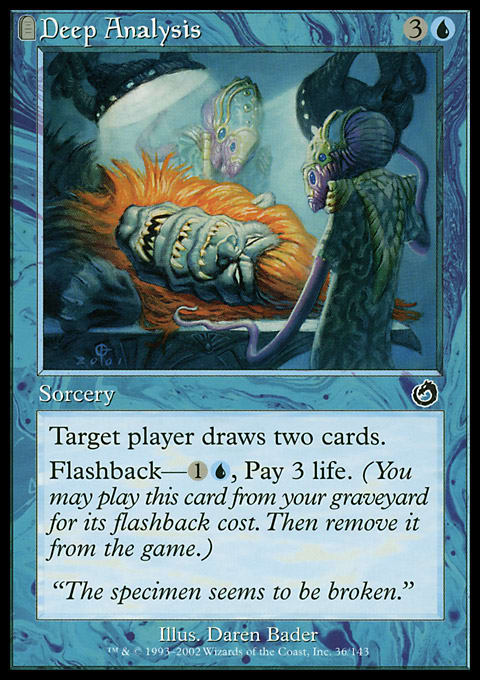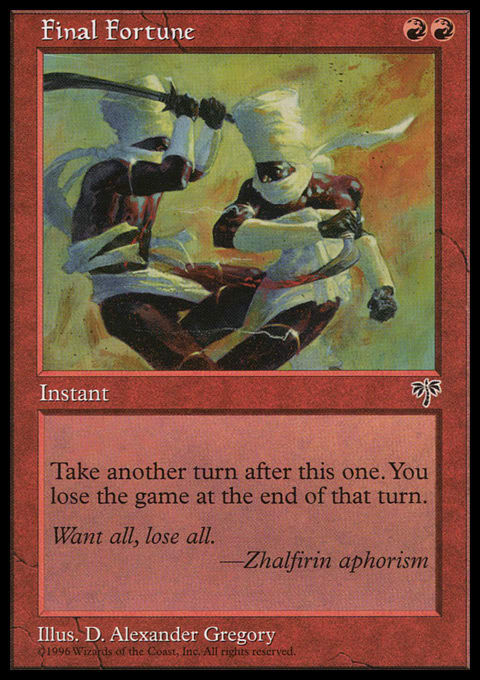If you have been reading this article series or following me on Twitter for the past few months, you already know about my shop-crawling expeditions as of late. The great part about shop crawling is that you can pick and choose what you are targeting and stick to what you know you can make money on.
If you see a $50 Underground Sea, you are obviously going to pick it up, but what if you see a bunch of five-slot boxes full of commons and uncommons? Do you know what cards—outside of the obvious Wastelands and Force of Wills—are worth money? This week, I am going to talk about what most will deem the least exciting part of the Magic financial market, and while I agree, it is also the most important part of what I do.
Careful Study!
The best way to familiarize yourself with better-than-bulk cards is to study; I’ll wait for the moaning to stop . . .
Like I was saying, fundamentally, this is unfortunately Organic Chemistry from college all over again—you don’t really want to learn it, but at its core, it’s just a bunch of memorization. The easiest method I have found to teach new people how to pick bulk is to provide those people with a visual aid. If you are picking a collection that has a variety of sets, this can become more difficult, but it’s still doable. Print out pictures of all of the cards that you find when scouring buy lists and make a little binder out of them, organized by set. Even if you don’t memorize every card right away, this is a good reference sheet, which over time, you should be finding yourself needing less and less.
You will always miss some cards, and at first, that bothered me a lot because I am a bit of a perfectionist when it comes to my work. In the end, however, I found that taking twice as long to make an extra dollar or two just isn’t worth the battle; leave something for the next guy since you are probably outing the true bulk to someone else.
The key is to remember the big cards—not many people know about commons and uncommons such as Squirrel Nest or Dragon Arch. For most competitive players, these cards would never pass the playability test, and therefore, they assume them to be bulk. The one thing you have to remember about this game, though, is that competitive players make up the minority. There are far more people who get together once or twice a week to play some casual kitchen-table games than there ever will be at a Grand Prix. Learning the cards that cater to this crowd will be one of the most profitable ventures you will find; even buying bulk from competitive players looks far more appealing when you broaden your horizons and realize how many cards actually have value.
Pop Quiz
Now that you have done your homework and studied hard, it’s time for your first exam. For this, I would suggest taking a box of cards you had already picked through, whether it be from a collection you picked up or just something you had lying around the house. Sit down with the box and your newfound knowledge of bulk and go to town. Keep your study guide handy and spend as much time as it takes to completely pick the box.
The first couple of times around, this may seem to be among the most brutal and monotonous things you have ever done, but by the end, you will be surprised by how much you missed when you picked the box before. Do this a number of times, and you will find yourself referencing the guide less and less and the process becoming quicker and far more streamlined.
When you finally reach the point at which you are comfortable with your skills, it is time to take them to the next level and put away the study guide. Bulk cards don’t change much over time because the casual crowd usually keeps the same interests throughout the years, so other than the occasional update when a new set comes out, there really isn’t much of a need to make a new list very often.
With the list securely tucked away, take a box of cards and start the process all over again. Think of this as the books-closed quiz before the actual test. If you still aren’t comfortable with your knowledge base, feel free to pull out the list and keep studying, but force yourself to at least go through the box once without it.
For some people, this process can be memorized in a matter of a few tries, but for others, it may take a few hundred thousand cards before you feel truly comfortable. The key is not to stress yourself out and take as much time as you need; this part, after all, is not a race, and it’s better at first to be a little slower but precise than quicker and inaccurate.
The Final
Once you are suitably comfortable with your skills, it is time to take what you have learned and put it to the real test. Ideally for this, you will have bought a collection with a box that contains a good mix of commons and uncommons from a multitude of sets. Pick the box, taking your time at first, making sure you don’t miss anything. Once you have made it through a few boxes and are confident in your picking skills, it is time to speed things up.
Picking a collection is only worth it if you can not only do it efficiently, but also quickly. The time you put into each thousand cards should be equivalent to its worth. If you find a collection that is full of gems, it is okay to take a little longer than if you have boxes that are full of true bulk. Time is money, after all, so you want to make it to a point at which you feel that it is actually worth your time to do this.
In order to make you more diligent in the picking process, set up a clock and time yourself. You don’t need to set a deadline at first or rush through it, but be aware of how long you are taking to make it through each thousand in comparison to how many cards you are pulling out. I can make it through an unsorted collection that is all unsleeved and faced correctly at a rate of about a thousand cards every ten to fifteen minutes. It’s faster if there is not much there, and it can take up to twenty minutes if it is jammed with good stuff.
Even though I have managed to make it up to that speed—and faster at times—that does not mean that is a good starting place. Start with double that time and work from there. If you give yourself a half hour on an average thousand cards, meaning you are pulling fifty to one hundred cards from it, you should be able to gauge whether you need some work. The process will speed up as time goes by and you find your rhythm, so don’t worry if it takes you a little longer at first; it comes with experience, and believe me: I have experienced millions of cards, so it’s not something that comes overnight.
Extra Credit
I have discussed picking bulk and some sleepers people may not know about from the past. I have never really talked about what to do when you have picked through the bulk and pulled out all of the loot, though. The best outlet for bulk really depends on how you conduct your business. If you are an eBay seller, putting together lots can prove to be among the most lucrative outlets you can find, but if you are like I am and don’t like dealing with the hassle of fees and unpaid listings, you need to find another source.
This is where online retailers come in handy because they will take almost everything—assuming it is not in terrible condition—at anywhere from four to five dollars per thousand. If you can prearrange a meeting at a major event near you, that can be a great way to unload the bulk while not losing any money on shipping or PayPal fees.
If you are not so lucky to have a major event near you or you want to put some extra effort into sorting a collection, I would suggest checking out CoolStuffInc. They have the best buy prices on bulk if you are willing to sort the cards by rarity and ship them. They are the only place I know of that will give you $15 on particular types of bulk per thousand.
Armed with this knowledge, you not only have a the ability to pick the bulk, but you also have an outlet for all of the chaff that no one else wants, keeping your living room from turning into a cardboard warzone such as mine has become.
Join me next week as I talk more about the road trips I have been taking and give you the rundown of how Minneapolis went a few weeks ago. I will be on my way to Columbus, Ohio by time this goes live, searching high and low for great deals and cardboard gold, so if you are at Origins this weekend, stop by the trade floor and say “hello.”
I hope you weren’t put to sleep this week—I know this can be among the least exciting parts of any floor trader’s life, but the revenue that this knowledge can bring is well worth the time and effort you will put into learning how to pick. As always, if you have any questions or comments, post them below or on my Twitter.
Ryan Bushard
@CryppleCommand on Twitter


























